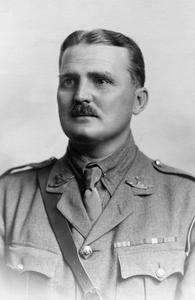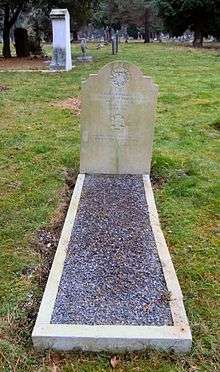John Sherwood-Kelly
John ("Jack") Sherwood Kelly VC CMG DSO (13 January 1880 – 18 August 1931) was a South African recipient of the Victoria Cross, the highest and most prestigious award for gallantry in the face of the enemy that can be awarded to British and Commonwealth forces. The four-times-wounded Kelly was not a Regular officer but a formidable and experienced commander with a combat record going back to the 1896 Matabele Revolt.[1]
John Sherwood Kelly | |
|---|---|
 John Sherwood-Kelly VC | |
| Born | 13 January 1880 Lady Frere, Eastern Cape |
| Died | 18 August 1931 (aged 51) London |
| Buried | (51°18′03″N 0°37′29″W) |
| Allegiance | |
| Service/ | |
| Years of service | 1896−1919 |
| Rank | Brigadier |
| Unit | Norfolk Regiment |
| Commands held | 1st Battalion, Royal Iniskilling Fusiliers |
| Battles/wars | Second Boer War Bambatha Rebellion World War I |
| Awards | Victoria Cross Companions of the Order of St Michael and St George Distinguished Service Order |
During his military career he achieved fame and notoriety for his mixture of heroic exploits and explosive temperament. He was awarded the Distinguished Service Order for his exploits in Gallipoli in February 1916 and on 1 January 1917 was awarded the Companion of St Michael and St George (CMG). During the summer and autumn of 1917 he commanded 1st Battalion, the Royal Inniskilling Fusiliers and was instrumental in the early success achieved during the Battle of Cambrai on 20 November for which he received the Victoria Cross from King George V at Buckingham Palace on 23 January 1918. Kelly was gassed and wounded at various times.
Early life
His mother died when he was 12 and his twin brother was killed falling from a horse when he was 13. His father subsequently married their governess giving him three half-siblings. He was educated in South Africa at Grahamstown (St. Andrew's College and St Aidan's), King Williamstown (Dale College) and Queenstown (Queen's College).
At 16 he fought in Matebeleland. He joined the Cape Mounted Police and was at the Relief of Mafeking in South Africa. He joined the Somaliland Burgher Corps fighting the "Mad Mullah" in Somaliland. In 1906 he took part in the suppression of the Bambatha Rebellion.
He married Nellie and prior to the outbreak of the First World War he was housemaster at Langley School, Loddon, Norfolk (England) and a member of the Territorial Force in the United Kingdom.
First World War
Gallipoli campaign
In Gallipoli, he commanded a regular army Scottish battalion.
Western Front
He was 37 years old, and an Acting Lieutenant-Colonel in the Norfolk Regiment, British Army, Commanding Officer 1st Battalion, Royal Inniskilling Fusiliers during the First World War when the following deed took place for which he was awarded the VC.
On 20 November 1917 during the Battle of Cambrai at Marcoing, France, when a party of men were held upon the near side of a canal by heavy rifle fire, Lieutenant Colonel Sherwood Kelly at once ordered covering fire, personally led his leading company across the canal and then reconnoitered, under heavy fire, the high ground held by the enemy. He took a Lewis gun team, forced his way through obstacles and covered the advance of his battalion, enabling them to capture the position. Later he led a charge against some pits from which heavy fire was coming, capturing five machine-guns and 46 prisoners.[2]
North Russia
According to Field Marshal Lord Ironside's account published in 1953, the second battalion of the Hampshire Regiment on 19 June 1919 under Kelly's command as part of the North Russia Campaign "failed to take any part in the fight" at Troitsa, a village encampment on the River Dvina and about 180 miles south-east from Archangel as the crow flies.[3] When Ironside interviewed Kelly the following day, Kelly could not explain the 2nd Hampshires' failure to take part in the action; had Kelly been a Regular officer, explained Ironside, he would "certainly have had him court martialled."[4] In view of Kelly's outstanding war record, Ironside merely withdrew the 2nd Hampshires from the line and directed that Kelly be sent home for demobilisation.[5] According to the Brigade Operation Report, however, Kelly's column at Troitsa was successful at first but then withdrew as he considered the position insecure and was having difficulty obtaining ammunition supplies; when ordered to resume the attack, Kelly declined to do so.[6]
According to Kelly's account given shortly after to his brigadier, a series of factors accounted for his withdrawal: slow and difficult approach through marshy woods, lack of information about the progress of other columns, stiff resistance by the enemy Bolsheviks, the danger of encirclement and lack of ammunition.[5] In the event, Kelly was not relieved of his command and sent home as Ironside (in his own words) had "decided to give him a second chance." Kelly was not dismissed until 17 August 1919 and then for quite different reasons than the Troista affair.[7]
In mid-April 1919, Sir Keith Price, a head of production at the Ministry of Munitions, wrote to the War Office urging the use of new variants of gas against the Bolsheviks in the North Russian theatre. Winston Churchill, then Secretary of State for War and Air, was enthusiastic in his support but was concerned at revealing the new gas in the course of a relatively small campaign.[8] Churchill's concerns having been addressed, massive preparations for the use of the new gas were undertaken. As a trial of the new weapon Kelly, who was now in command of a very mixed outfit on the railway front as part of the Vologda Force, was ordered to carry out a raid on the Bolsheviks under cover of a large ground discharge of gas. Kelly objected less against the gas as against the raid itself whose purposes in his view could be achieved by other methods.[9] The gas raid, due on 17 August 1919, never took place. Kelly was then replaced as commanding officer of his unit and sent back to Britain; the formal reason for his removal was that he had "remarked adversely on matters of military import", criticised his superiors and divulged military secrets in a letter to a friend in England; the contents of the letter constituted a court martial offence.[10]
On his arrival back in Britain, Kelly wrote a series of letters to the Daily Express and Sunday Express, both published by Lord Beaverbrook and both opposed to the North Russia Campaign. The first letter appeared on 6 September 1919 in the Daily Express.[11] Urgent consultations within government as to a possible court martial for Kelly followed the publication.[12]
"A court martial would be an unusual disciplinary procedure for an officer, rare for one of Kelly's rank, unprecedented for one so well decorated, four times wounded (twice gassed) and nine times mentioned in despatches."[5]
Initially the Adjutant General advised against a court martial, suggesting instead that Kelly be removed from the army administratively for misconduct as permitted by an article of the Pay Warrant. However, after the publication by Beaverbrook of a second Kelly letter Churchill favoured Kelly's swift court martial for writing to the newspapers but without reference to anything which had happened or was alleged to have happened in Russia.[5] Kelly was arrested on 13 October 1919; his court martial took place on 28 October 1919 in Westminster Guildhall on the charge of having written three letters to the press on 5 September, 12 September and 6 October 1919 after his return from Russia. Kelly pleaded guilty to contravention of the King's Regulations which provided that an officer was,
"forbidden to publish in any form whatsoever or communicate, either directly or indirectly, to the Press any military information or his views on any military subject without special authority."[13]
Kelly presented a plea in mitigation and various documents to support his case. He concluded,
"I plead with you to believe that the action I took was to protect my men's lives against needless sacrifice and to save the country from squandering wealth it could ill afford."[5]
He was found guilty and severely reprimanded. Two weeks later he relinquished his commission, being allowed to retain the rank of lieutenant colonel. Pursued by a neglected wife and various creditors, he was unsuccessful in his many attempts to re-enter the army and even failed to obtain a place in the French Foreign Legion.[5]
Politics
During the political instability of 1923–24, Jack Kelly stood for the Conservative Party at two general elections for the constituency of Clay Cross in Derbyshire. His controversial and outspoken style struck a chord even among hardened socialist supporters in this largely mining seat. He was defeated in the December 1923 elections by 6,000 votes but had reduced this by half a year later in the election of October 1924. During the election rallies, Kelly again hit the national headlines having thrashed some hecklers at Langwith.
Later work

In later years, Kelly worked for Bolivia Concessions Limited building roads and railways across Bolivia and went big game hunting in Africa where he contracted malaria, from which he subsequently died.[13] He was granted a full military funeral and buried at Brookwood Cemetery[13] in Surrey, England.
The Medal
His Victoria Cross is displayed at the National Museum of Military History in Johannesburg.[14]
References
- Kinvig 2006, p. 193.
- "No. 30471". The London Gazette (Supplement). 8 January 1918. p. 722.
- Ironside 1953, pp. 152–153 quoted by Kinvig 2006, p. 194
- Kinvig 2006, p. 194.
- Kinvig 2006.
- Kinvig 2006, pp. 194-195.
- Kinvig 2006, p. 196.
- Kinvig 2006, p. 183.
- Kinvig 2006, p. 244.
- Kinvig 2006, p. 245.
- Kinvig 2006, p. 247.
- Kinvig 2006, p. 333.
- Kinvig 2006, p. 334.
- "Medals held by the South African National Museum of Military History". Retrieved 14 January 2013.
- Bujak, Philip (2008). Undefeated: The Extraordinary Life and Death of Lt. Col. Jack Sherwood Kelly, VC, CMG, DSO. Forster Consulting. ISBN 978-0-9551902-2-3.CS1 maint: ref=harv (link)
- Gliddon, Gerald, ed. (1998). Norfolk & Suffolk in the Great War. Gliddon Books. ISBN 0-947893-07-5.CS1 maint: ref=harv (link)
- Harvey, David (1999). Monuments to Courage : Victoria Cross Headstones and Memorials. Vol.1, 1854–1916. Kevin & Kay Patience.CS1 maint: ref=harv (link)
- Ironside, Edmund (1953). Archangel 1918-1919. London: Constable. ISBN 978-1-84734-732-9.CS1 maint: ref=harv (link)
- Kinvig, Clifford (2006). Churchill's Crusade: The British Invasion of Russia, 1918-1920. Hambledon Continuum. ISBN 978-1-85285-477-5.CS1 maint: ref=harv (link)
- The Register of the Victoria Cross (This England, 1997)
External links
- Portraits of John Sherwood-Kelly at the National Portrait Gallery, London
- Location of grave and VC medal (Brookwood Cemetery)
- The Brookwood Cemetery Society (Known Holders of the Victoria Cross Commemorated in Brookwood Cemetery)